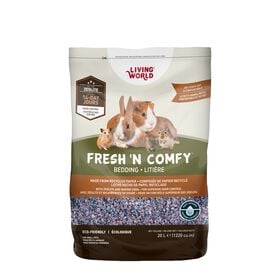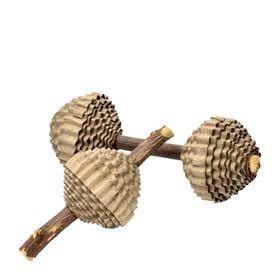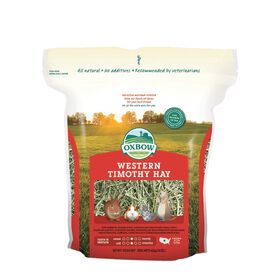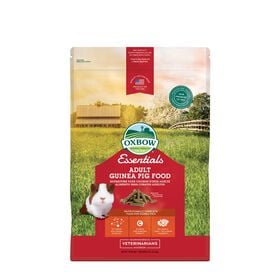Guinea pigs. Such adorable little creatures. So adorable, in fact, that you may be thinking about getting one! If so, be sure to take some time and properly inform yourself first, considering your potential pet’s needs along the way. Doing so helps ensure you’ll both live happily ever after.
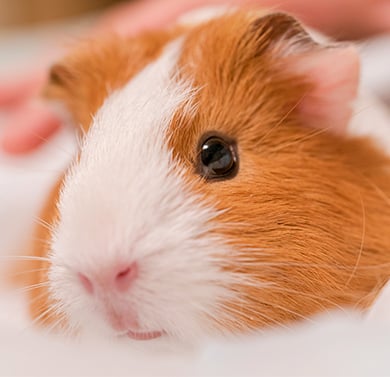
Domesticating your guinea pig
Known as a more social pet, guinea pigs are relatively easy to domesticate. But it’s important to remember to stay calm and practice patience when training them: Guinea pigs are nervous animals. The first thing to do is find a quiet part of the house, away from loud noises and any coming-and-going. Next, give your pet a gentle pat on the head. He’ll definitely try to escape your hands, but just continue very gently. Next, set him down in your lap and caress him gently until he calms down, and then give him a treat as a reward. This process will teach him to relax a bit, and he won’t try as hard to escape you as a result! Repeat these steps in short sessions so as not to disturb your guinea pig too much.
Fun fact: guinea pigs are highly social creatures! They love being around people, in fact, and it is for this reason we recommend placing their cage in a more lively part of the house. Just remember to steer clear of doors and any area that is likely to have a breeze.
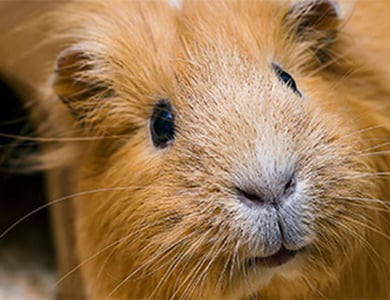
Guinea pigs are perfectly fine in a rabbit’s cage, provided they are alone. If you happen to have a couple of guinea pigs, you’ll simply need a more spacious cage. Verify that the cage is solid and that your pet won’t be able to escape.
The bedding you choose must be non-irritating, non-toxic, absorbant and easy to change. Some options are below:
- Hay and straw: Hay must absolutely be a part of any Guinea pig diet
- Recycled paper bedding (compressed or in flakes)
- Newspaper, though it can be dirty and not sufficiently absorbant
- Shavings: Opt for sturdy wood chips, such as aspen, and avoid white cedar or pine shavings as these irritate the respiratory system.
Also, it’s important that you equip their cage with a few knick knacks to help them feel at home. Some examples are below :
- A little house made of wood or cardboard
- Toys
- A watter bottle
- A food bowl (preferably ceramic)
- A bowl for fruit and vegetables
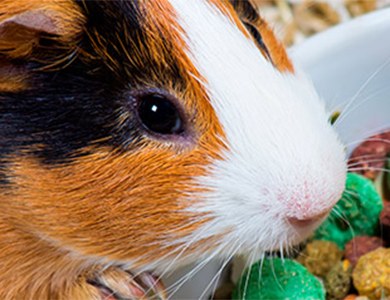
What do guinea pigs eat, anyway?
When it comes to diet, guinea pigs can be picky little things. However, there are a number of options for balanced meals on the market that they gladly chow down on. Whether cubed or extruded, these meals are specially formulated to satisfy your guinea pig’s needs. Typically, they’ll consume roughly 35 grams a day (roughly 13 kg per year). They’ll also love guinea pig feed, timothy-grass hay, fruit (in small quantities), and fresh vegetables every day. Never give them a large serving of green cabbage or broccoli: these can cause flatulence. We recommend giving them some fruit and some rinsed vegetables every morning and evening. Guinea pigs often prefer green vegetables, but they also love orange- and yellow-coloured vegetables.
Foods to avoid:
- Raw potatoes
- Beet leaves
- Rhubarb leaves
- Nut-, grain-o or corn-based mixes: these are too high in fat and can lead to health problems
- Onions, garlicand avocado are all toxic
Also, unlike other rodents and rabbits, guinea pigs need a vitamin C supplement in their diet. Like humans and monkeys, these rodents aren’t capable of synthesizing vitamin C on their own. It is it therefore crucial that you not give your guinea pig rabbit food — despite the striking resemblance.
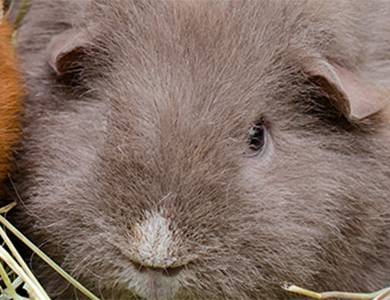
Guinea pigs like hay
Though it’s important to make sure your guinea pig has constant access to hay, be careful when it comes to feed, and be sure to distribute it in portions. If your guinea pig happens to be heavier, take a good look at his quantities. Guinea pigs like a big hefty serving of hay every day. Whichever mix you choose, make sure it contains multiple species of vegetable — don’t just give him a handful of alfalfa (it contains too much calcium, which can cause urinary problems such as bladder stones and infections). Hay will help keep the digestive system and teeth in good health. It will also give your pet something to do, which means he’ll have less opportunity to develop any behavioural issues.
Furthermore, ensure your pet has water to access at all times. Remember: guinea pigs who are used to drinking from a bowl might have trouble getting used to a bottle. Unfortunately, they could even die if they don’t become familiarized with it. For these reasons, keep an eye on your pet. Also, remember each day to add 50mg of vitamin C to their water in tablet form.
Ready to adopt?
When the big day comes, make sure the guinea pig you adopt is at least six weeks old: animals that are weaned before this age will become vulnerable to illness.
Once you’ve found the guinea pig that’s right for you, have him examined within 48 hours by a vet who is versed in rodent care. This will help you get off on the right foot!


